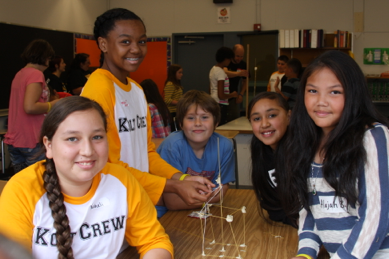The Developing Brain
Adolescence is a time of a tremendous development and transition. Middle schoolers are not only experiencing physical changes associated with puberty, but they are also experiencing social and emotional challenges tied to adolescent brain development.
 Advances in the science of brain development indicate that, second only to the first five years, middle school is a period of rapid brain development – in particular, social emotional learning and empathy maturity. For most tweens and young teens, these are the years when transition from childhood to adulthood begins, new peer and social influences come into play, and jealousy, anger, and pressure to conform are felt in more powerful and personal ways.
Advances in the science of brain development indicate that, second only to the first five years, middle school is a period of rapid brain development – in particular, social emotional learning and empathy maturity. For most tweens and young teens, these are the years when transition from childhood to adulthood begins, new peer and social influences come into play, and jealousy, anger, and pressure to conform are felt in more powerful and personal ways.
This time is often misunderstood and underestimated as a critical opportunity to instill strong values, build resiliency, and develop character. It is in middle school where the foundation of a young person’s ability to overcome adversity must be cemented and in high school, strengthened. These are the critical years when effective prevention must begin.
Immature brain development
Boys and girls at this age are interacting with peers, seeking meaning, and learning about who they are. But why are adolescents often acting out, engaging in risky and impulsive behaviors, and doing things without planning?
The latest research indicates that a part of the adolescent brain is not fully mature until the early 20s. Researchers call this a “mismatch” in maturation of the brain networks, a “gap” in development, or immature brain circuitry.
As a result, the links between this late developing prefrontal cortex of the brain, responsible for problem-solving and making judgments/decisions, are not yet connected to centers in the limbic system, like the amygdala, responsible for emotions.
What this means is that for adolescents, the frontal cortex of their brains are not yet fully developed enough to help them make decisions or reason whether something “is a good idea” or what the consequence are of their actions.
 Differences in brain maturity and chemistries
Differences in brain maturity and chemistries
Girls and boys also differ in their brain development and chemistries, which may account for their learning and behavioral differences. In relationships for instance, girls may “tend and befriend” while boys may use a strategy of “fight or flight.” Boys may take more risks while girls may foster relationships.
The differences may be attributed to how the brain develops in girls compared to boys. The cortex of the brain is composed of gray matter and white matter. In girls there is a higher proportion of gray matter associated with stronger verbal skills and multitasking, while in boys there is a higher proportion of white matter connected with spatial skills.
In adolescent females, the larger hippocampus, sensitive to the female hormone, estrogen, is connected to strong social skills, being emotionally supportive, and coordinating complex relationships. In young men, the growth spurt in the amygdala and hypothalamus, which are sensitive to the male sex hormones, impacts the body’s response to fear and danger. This is associated with young boys’ enjoyment of contact sports, an increase in sexual desire, and assertiveness.
Understanding these physiological differences in adolescent girls and boys can help professionals strategize and respond appropriately.
 Some suggested strategies:
Some suggested strategies:
- Take advantage of gender-based or specific learning differences.
- Promote service learning to help youth develop leadership, compassion and skills in different settings.
- Note how males and females may display differently the emotions and feelings that they each are internalizing.
- Promote physical activity for both males and females, important for healthy brain development as much as their studies.
- Train staff on how to intervene positively and effectively in bullying

RESOURCES
- The Emotional Brain is in Transition
- The Amazing Adolescent Brain: What Every Educator, Youth Serving Professional, and Healthcare Provider Needs to Know
- The Teen Brain: Still Under Construction
- How Traumatic Experiences Can Affect Children’s Brains


